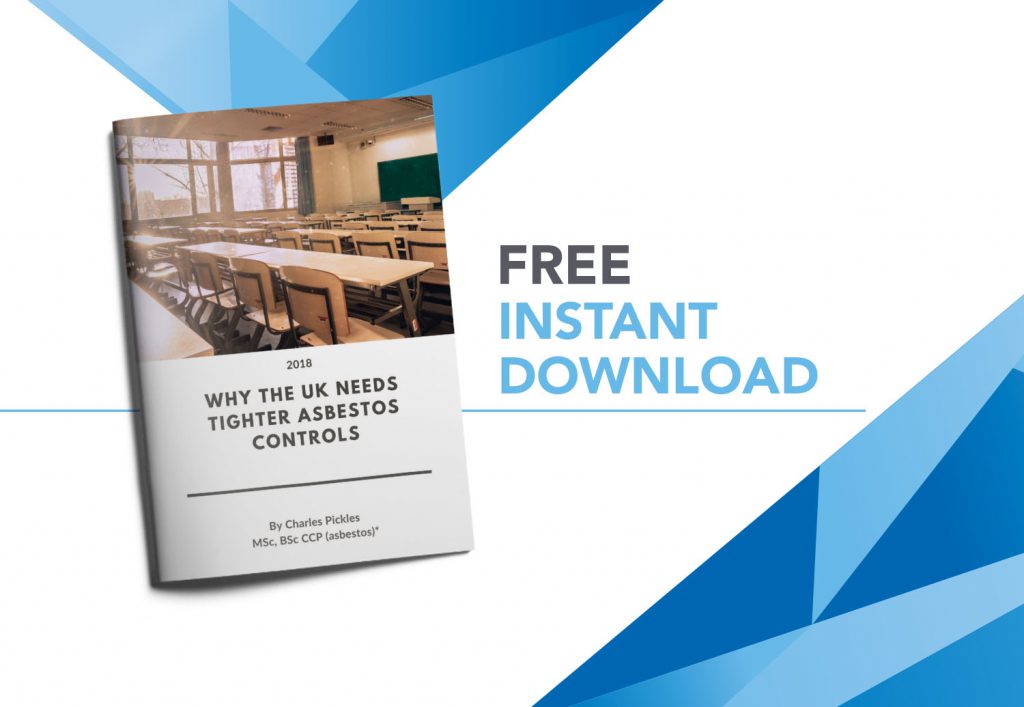PLANNED PROTECTION: ASBESTOS MANAGEMENT PLANS
18 January 2020
Writing an Asbestos Management Plan may seem like just another item on an extensive to-do list. If you are currently managing asbestos in your property/assets or you are considering construction or renovation activities, it is important that all asbestos risks are assessed, including identification and management. It is imperative that you have an accurate, up-to-date Asbestos Management Plan in place.
An Asbestos Management Plan (AMP) is a written plan detailing how you, the duty holder, will manage asbestos risks within your buildings and assets constructed pre 2000. The items detailed in your asbestos management survey will form the foundations for this plan. AMPs are a legal requirement for all workplaces liable to contain asbestos under the Control of Asbestos Regulations 2012.
What Does The AMP Contain?
The AMP contains information about how you will control asbestos exposure, not only below the control limit, but to the lowest practicable limit. Sections will include information on future plans, timescales, Safe Systems of Work (SSoW), management structure and more. The purpose of the AMP is to outline the process of managing asbestos risks from cradle to grave. The document is designed to be dynamic; continuously updated as the building evolves. It will provide clear methods of communication with all relevant stakeholders to ensure they have the relevant information and training.
Having a thorough but concise AMP will aid cohesive working and understanding between all relevant parties. An effective AMP is a fundamental step in protecting not only workers and individuals but also business reputation.
Remember The Reader
It’s important when writing your AMP to consider the reader. Whilst it is beneficial to make all of the details and information for your site readily available and accessible, you must ensure that your AMP is going to be read, digested and applied. Creating a user-friendly, easy to read document that is both informative and concise will be more beneficial to both your teams and contractors over an extensive, word-heavy document. Expecting all contractors to read and digest a document excessive in length may result in key information being missed and ineffectively communicated to other workers.
Before starting your AMP ensure you know the key points you want and need to communicate to the reader. Be concise. Be cohesive. Keep in mind that you will be responsible for updating your Asbestos Management Plan as things change. An extensive 100-page document may not necessarily be easy to manage in the long term.
Writing Your Plan
The AMP can be divided into many subdivisions covering building history, legislation, surveys and inspections, training and much more. Overall the AMP and its subsections can be split into four main headers:
- What do you know so far?
- Action and management
- Reviews and updates
- Communication
What Do You Know So Far?
The first step in writing your Asbestos Management Plan is to inform readers (internal teams, external contractors, facilities and asset managers, auditors and other relevant stakeholders) of what you already know about your buildings, assets, and risks. This should include:
- History – details of company sites and assets including when the building was erected, the surrounding lands, the activities that occur in the building/asset and the equipment being used.
- Location – details of which site and asset the plan applies to. Often AMPs are applicable on a site by site basis to ensure enough detailed information about the site is communicated to relevant parties.
- Duty Holder – who is responsible for all activities that surround asbestos and those who may come into contact with asbestos risks and ensuring they comply with plan, that they are effectively trained and protected.
- AMP Access – details of where the Asbestos Management Plan can be accessed (either digital and printed copies).
- Asbestos Register – details of where Asbestos Register, detailing the location of the asbestos hazards are, can be accessed and frequency that it should be updated.
- Regulations – which regulations and legislation the AMP applies to.
- Training – details of what training is required and where current training records can be accessed.
- Contractors – a list of currently approved contractors and who has access to site or the process of employing 3rd party contractors.
Action And Management
The action and management section of the Asbestos Management Plan outlines all the actions that will take place when effectively managing asbestos risks. This should also include related risk assessments and safe practices that will be put in place to ensure safeguarding and protection of life is maintained. These actions include:
- Action Plan – Short, medium and long-term KPIs to be achieved during the ongoing management of the building that ensures the continued effective management of the asbestos risks. Using your contractor/providers contract to monitor and outlay KPIs can be an effective step in managing the process of achieving your goals and timelines.
- Priorities – all actions within the AMP should be prioritised in accordance with the priority assessment conducted by the duty holder so that contractors and teams are aware of what is expected and can manage their timelines accordingly. These should work in conjunction with priority assessments where high-risk Asbestos-Containing Materials (ACMs) that are likely to be disturbed are risk assessed as a first priority.
- Timelines – Ensuring timescales are not only verbally communicated, but are recorded in the AMP will help to manage stakeholders expectations when conducting risk and material assessments.
- Procedures – Communicating standards, processes and procedures such as how ACMs should be categorised (i.e. manage in situ or remove), caveats, waste-removal etc. all come under management actions which should be detailed in the AMP. Importantly Safe Systems of Work (SSoW) ensuring necessary precautions are taken when carrying out any future works.
- Training and induction schedule required to ensure all site occupants have been considered and suitable/adequate training is in place i.e. Asbestos Awareness Training.
- Monitoring – Ongoing assessments of asbestos and the related risks are required throughout the life of the building where asbestos exists (this may include asbestos air monitoring). If asbestos is being managed in situ annual re-inspection surveys will be required to monitor the condition of the asbestos-containing material and ensure effective prevention measures are in place to minimise the risk of potential asbestos exposures.
- Emergency Procedures – In the event of an emergency or an incident of asbestos exposure, it is imperative that the procedures for dealing with the situation are communicated and noted in the AMP.
Reviews And Updates
The AMP should be reviewed regularly, especially when any changes to the building or asset occur. This includes any changes to the asbestos within the building or asset. Reviewing the effectiveness of the plan and processes put in place will help to inform of any amendments that may need to be made in order to help manage the asbestos risks.
Reassessing the plan when business and organisational changes take place will also help prevent a build-up of unreliable, insufficient documentation. If you are using historic asbestos documentation to inform your Asbestos Management Plan; but there is no trail or timeline relating to that documentation, it may be time to review the reliability of the information being used.
Learn more about the risks of relying on inherited documentation here: Trusting Your Asbestos Documentation.
Communication Is King
A keyword used throughout the Asbestos Management Plan is communication. Ensuring that there is a procedure in place where access to the AMP is given to your team, contractors and providers is a key step to implementing an effective protection strategy. If you have collated a cohesive, user-friendly and highly informative AMP and asbestos register but no one knows where to access it or, contractors are not actively given a copy (digitally or physically), the AMP and the asbestos register become useless.
Ensure your AMP is readily accessible and safeguard your teams, external contractors and your reputation.
Further Reading
Lucion Services – Asbestos Management Plans: http://www.lucionservices.com/services/asbestos-management-plans/
HSE Managing My Asbestos – Are You The Duty Holder?: http://www.hse.gov.uk/asbestos/managing/responsible.htm
Lucion Services – Asbestos Surveys: http://www.lucionservices.com/services/asbestos-survey/
HSE – Control Of Asbestos Regulations 2012: http://www.hse.gov.uk/asbestos/regulations.htm
Using The Contract To Measure Your Provider’s Performance: http://www.lucionservices.com/its-not-just-about-the-price-using-the-contract-to-measure-your-providers-performance/
Lucion Services – Safe Systems of Work: http://www.lucionservices.com/services/rams-and-ssow/
Lucion Consulting – Asbestos Training Courses: http://www.lucionservices.com/training-course-categories/asbestos/
HSE – Example Asbestos Register: http://www.hse.gov.uk/asbestos/assets/docs/registerscores.pdf
Lucion Services – Asbestos Air Monitoring: http://www.lucionservices.com/services/asbestos-fibre-air-monitoring/
Lucion Services – Re-Inspection Asbestos Survey: http://www.lucionservices.com/services/asbestos-survey/
Asbestos The Truth – Trusting Your Asbestos Paperwork: http://www.lucionservices.com/trusting-your-asbestos-paperwork-documentation/
HSE – Managing And Working With Asbestos: http://www.hse.gov.uk/pUbns/priced/l143.pdf
HSE – Managing Asbestos In Buildings Guide: http://www.hse.gov.uk/pubns/indg223.pdf
Asbestos Management Plan: 12 Step Checklist
Struggling to get started with your Asbestos Management Plan? Download our free 12 step AMP Checklist Guide and take the first step to safeguard your teams, contractors, and reputation.
No Sign-Up Required
RPE Face Fit Test Guide
Depending on the type of work being conducted, employees identified (through risk assessments) as being at risk of exposure to hazardous dust or other respirable substances must wear suitable face-fit tested RPE.
Discover the various types of RPE and whether your RPE needs to be face-fit tested with our free download from Lucion Consulting.
_1.png)
Download From NexGen
Tool Box Talk: Asbestos Awareness
As part of Lucion’s Take Care Be Aware initiative, we actively take care of our health and safety responsibilities, with continuous awareness of our commitments to knowledge share and educate.
In doing so we have created a ‘toolbox talk’ on asbestos awareness to raise awareness of the hazards associated with asbestos-containing materials, enabling safety professionals to share knowledge and overall save the time and effort in producing them for you and your teams.
_2.png)
Download From NexGen


 NexGen
NexGen












